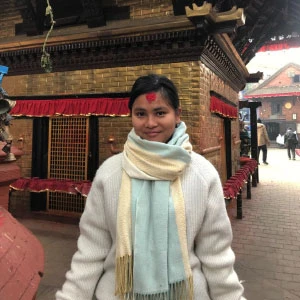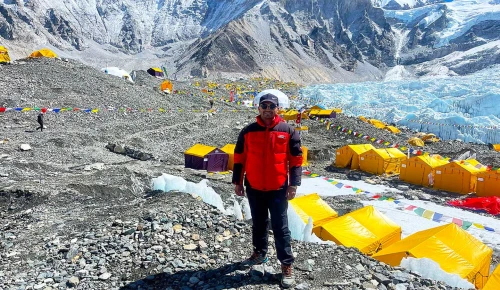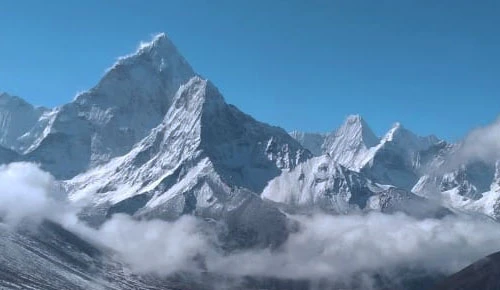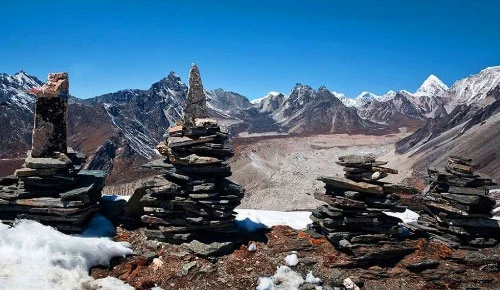Kanchenjunga Trekking Routes: North Base Camp vs. South Base Camp
“If you’ve ever dreamed of standing at the foot of the world’s third-highest mountain, surrounded by untouched wilderness, the Kanchenjunga trek is your ultimate adventure—but which route will reveal its true magic: North or South Base Camp?”
The Kanchenjunga remains a mountain frontier, remote, wild and lovely compared with the Everest and Annapurna region, where such tea houses and heavy traffic have become so common. It lies in the extreme east of Nepal, on its border with Sikkim (India) and Tibet; it provides the trekker a civilized Himalayan adventure where culture, nature, and adventure meet.
A Kanchenjunga expedition is a journey into a calm world, a world where high mountains, glittering glaciers, alpine meadows and fertile subtropical valleys are shown in enormous contrast. It is also a cultural adventure trip in which you visit the villages of Rai, Limbu, Sherpa, and Tibetans; each of them has its tradition, hospitality, and mountain-shaped lifestyle.
However, the actual decision trekkers have here is: which base camp of Kanchenjunga—North or South—would you like to trek? Each of the routes is charismatic. Pangpema (5,143 m), or North Base Camp, is an ideal place to see the magnificent north face and glaciers of Kanchenjunga and is a popular destination with those interested in rugged wilderness experiences and sweeping mountain vistas. The South Base Camp (4,610 m) offers the same, but with varying landscapes, rhododendron forests, terraced fields, and rich cultural experiences along the way, it is equally rewarding.
We are going to explore both of these routes in-depth in this blog, compare their attractions, and help you determine whether the North, the South, or possibly the combined circuit trek is the greatest adventure you can have.
Table of Contents
Overview of Kanchenjunga Trekking Routes
The Kanchenjunga Trek is one of the most spectacular and difficult trekking expeditions, set against the backdrop of the world's third-highest mountain, Mount Kanchenjunga (8,586 m).
Far in the east of Nepal, this trek travels through the beautiful Kanchenjunga Conservation Area, which harbors elusive animals such as red pandas and snow leopards, along with tall rhododendron forests, alpine meadows, and ancient villages where Sherpa, Rai, and Limbu communities reside. Compared to the overrated Everest and Annapurna routes, the Kanchenjunga trails remain quieter, providing a rare opportunity to remain above peace and solitude—the authentic composition of the Himalayas for many.
Along with the Restricted Area Permit, Trekkers require the Kanchenjunga Conservation Area Permit (KCAP), both of which a registered trekking agency arranges. The recommended time is in spring (March–May) and autumn (September–November), with the clearest skies and trails dotted with blooming flowers or adorned in golden autumn leaves, with the breathtaking vistas of mountains at their best.
With treks ranging from 12 to 20 days, depending on whether you choose the North Base Camp, South Base Camp, or the full Circuit, this adventure combines breathtaking scenery, cultural exposure, and sheer wilderness exploration.
Kanchenjunga North Base Camp Trek (Pangpema)
The North Base Camp Route of Kanchenjunga, or the Pangpema Route, stands as one of the most thrilling and scenic trekking trails of East Nepal. The trek typically starts from Taplejung, after a one-hour flight or a long and tiresome journey from Kathmandu, gradually ushering travelers through charming villages and terraced farmland with acute rhododendron and pine forests.
As the trail ascends the Ghunsha River Valley, trekkers pass unique Tibetan-influenced settlements like Ghunsha Village. The last leg toward Pangpema is adorned with breathtaking views of towering peaks, hanging glaciers, and the rugged terrains of the Kanchenjunga Conservation Area. At about 5,143 meters in elevation, Pangpema offers sprawling panoramic views coveted by mountaineers and tourists alike of the north face of Mount Kanchenjunga, the world's third highest mountain. This trek is demanding but satisfying and can be an excellent choice for thrill-seekers wanting to take a less traveled route in Nepal.
Highlights of Kanchenjunga North Base Camp Trek (Pangpema)
- Stunning panoramic view of the north face of Mount Kanchenjunga from Pangpema
- Remote and less-crowded trekking experience with authentic mountain culture
- Scenic trails passing through rhododendron forests, rivers, and high alpine terrain
- Close encounters with local villages like Ghunsha showcasing Tibetan-Buddhist culture
- Diverse landscapes ranging from lush valleys to rugged, glacial terrains
- Abundant wildlife inside Kanchenjunga Conservation Area, including chances to spot rare species
Kanchenjunga South Base Camp Trek (Oktang)
The Kanchenjunga South Base Camp Trek, also known as the Oktang Base Camp Trek, takes you to the southern face of Mt. Kanchenjunga, the world’s third-highest mountain at 8,586 meters. Starting from the vibrant town of Taplejung, this route gradually ascends through terraced farmlands, rhododendron forests, and picturesque villages inhabited by Limbu and Sherpa communities. The trek offers a perfect blend of cultural encounters and breathtaking mountain views, making it an ideal choice for trekkers who wish to experience both natural beauty and local traditions.
As you gain altitude, the landscape transforms from lush green hills to alpine meadows and glacial moraines. The trail leads to Oktang Base Camp (4,730 m), where trekkers are rewarded with awe-inspiring views of Kanchenjunga’s South Face, Yalung Glacier, and surrounding peaks such as Jannu, Rathong, and Kabru. The trek typically takes around 12–14 days, depending on the itinerary and acclimatization stops. Compared to the North Base Camp, this route is often considered slightly easier, with fewer steep ascents, making it suitable for moderate trekkers seeking adventure without extreme challenges.
Highlights of Kanchenjunga South Base Camp Trek (Oktang)
- Stunning close-up views of Kanchenjunga South Face and Yalung Glacier
- Picturesque Limbu and Sherpa villages with rich cultural traditions
- Lush rhododendron forests, alpine meadows, and diverse landscapes
- Breathtaking panoramas from Oktang Base Camp (4,730 m)
- Remote and less-crowded trekking route offering solitude
- Opportunity to spot rare wildlife in the Kanchenjunga Conservation Area
Key Differences Between Kanchenjunga North and South Base Camp Routes
Both the Kanchenjunga North Base Camp Trek (Pangpema) and South Base Camp Trek (Oktang) offer unique trekking experiences in the remote eastern Himalayas of Nepal. The North Base Camp is ideal for adventure seekers looking for dramatic landscapes, high-altitude challenges, and panoramic mountain views, while the South Base Camp offers a blend of cultural encounters, moderate trails, and close-up views of Kanchenjunga’s South Face and Yalung Glacier. For trekkers with enough time, combining both routes creates the full Kanchenjunga Circuit Trek, covering the best of both worlds.
Comparison Table: North Base Camp vs. South Base Camp Routes
| Features | North Base Camp (Pangpema) | South Base Camp (Oktang) |
|---|---|---|
| Starting Point | Taplejung – Ghunsa | Taplejung – Yamphudin |
| Maximum Altitude | Pangpema (5,143 m) | Oktang (4,730 m) |
| Trek Duration | 15–18 days | 12–14 days |
| Difficulty Level | Challenging, steep ascents, higher altitude | Moderate, gradual ascents, easier compared to the North |
| Scenery | Vast glaciers, rugged terrains, high passes, alpine views | Lush forests, terraced farmlands, Yalung Glacier views |
| Cultural Experience | Remote Tibetan-influenced villages | Limbu and Sherpa communities, cultural homestays |
| Major Highlights | Pangpema viewpoint, Kanchenjunga North Face, glaciers | Oktang viewpoint, Kanchenjunga South Face, Yalung Glacier |
| Best Season | Spring (Mar–May) & Autumn (Sep–Nov) | Spring (Mar–May) & Autumn (Sep–Nov) |
| Wildlife Encounters | Blue sheep, snow leopards (rare) | Red pandas, Himalayan monals |
| Trek Popularity | Less crowded, adventurous trails | Slightly more popular among cultural and scenic trekkers |
| Full Circuit Option | Can be combined with South Base Camp | Can be combined with North Base Camp |
Choosing the Right Route for You
When deciding between the North and South Base Camp routes in the Kanchenjunga region, trekkers often consider factors like scenery, cultural experiences, trail difficulty, and time availability. Both routes offer unique perspectives of the world’s third-highest mountain, but the right choice depends on your personal trekking preferences and adventure goals.
- North Base Camp is ideal for trekkers who love remote landscapes, dramatic glaciers, and close-up views of towering peaks.
- The South Base Camp route offers more cultural encounters, with traditional villages, monasteries, and diverse local lifestyles along the trail.
- North Base Camp has steeper sections and higher altitudes, making it slightly more challenging and suitable for experienced trekkers.
- South Base Camp trails are comparatively moderate, making it a better option for those seeking a balanced mix of adventure and culture.
- If panoramic viewpoints are your priority, the South Base Camp (Oktang) rewards trekkers with breathtaking vistas of Kanchenjunga’s South Face.
- For those seeking solitude and rugged wilderness, the North Base Camp (Pangpema) provides a more remote and less crowded experience.
- Trekkers with sufficient time and stamina can combine both routes into the Kanchenjunga Circuit for the ultimate adventure.
- The choice also depends on weather conditions, as some trails may be easier to navigate in certain seasons.
- Your physical fitness, trekking experience, and interest in local culture versus wild landscapes should guide your decision.
- Consulting with local trekking agencies helps you pick the right route based on real-time trail conditions and logistics.
Essential Trekking Tips Kanchenjunga Trekking Routes
Trekking to Kanchenjunga North or South Base Camp takes you through remote trails, diverse landscapes, and varying altitudes. To ensure a safe and enjoyable experience, proper preparation, fitness, and knowledge of the region are essential. These tips will help you stay well-prepared, manage challenges effectively, and make the most of your trekking adventure.
Essential Trekking Tips
- Begin physical training at least a month before the trek to build stamina and endurance for long walking days.
- Acclimatize properly by including rest days in your itinerary to avoid altitude sickness.
- Stay hydrated throughout the trek by drinking at least 3–4 liters of water daily.
- Carry warm layers and quality trekking gear as temperatures can drop drastically at higher altitudes.
- Use sturdy, well-fitted trekking boots to prevent blisters and ankle injuries on rough terrain.
- Pack light but include essentials like a good sleeping bag, headlamp, water purification tablets, and first-aid kit.
- Carry some high-energy snacks like nuts, energy bars, and chocolates for quick energy boosts.
- Hire a licensed guide or porter for navigation, safety, and local cultural insights.
- Get the required permits (Restricted Area Permit, Kanchenjunga Conservation Area Permit) in advance through a trekking agency.
- Keep some cash handy, as ATMs and digital payment options are limited in remote areas.
- Be mindful of the environment by following the "leave no trace" principle and using reusable bottles and bags.
- Start trekking early in the day to avoid afternoon weather changes and ensure timely arrival at teahouses.
- Travel insurance covering high-altitude trekking and emergency evacuation is highly recommended.
- Respect local customs and traditions when visiting villages, monasteries, or interacting with locals.
- Stay updated on weather forecasts and be flexible with your itinerary in case of unexpected conditions.
Conclusion
The two Kanchenjunga climbing trails will provide the same great experience, though they will cater to a different category of trekkers:
- North Base Camp (Pangpema): It will introduce high-altitude adventure fliers to the complete Himalayan wilderness and mountainous panorama.
- South Base Camp (Oktang): This is where the trekker will get a taste of culture, scenery, and a not-too-challenging trail.
The joint expedition, depending on time, fitness, and adventurous spirit, is the final step to witnessing Kanchenjunga in all its glory.
Would you like to have a glimpse of the virgin Kanchenjunga? Nepal Trek Adventure can assist you in creating your own adventure with excellent trekking routes and treks that you will not forget, with the help of qualified guidance. Begin your Kanchenjunga now!








